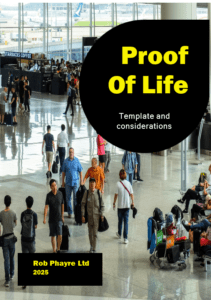In this article we will explore the concept of Proof of Life. What is it, when is it used, and how do you prepare proof of life questions if you are at risk of being kidnapped for ransom.
What is Proof of Life?
Proof of Life, or POL as it is sometimes shortened to is the process through which a family or company can determine if a hostage is alive. It also confirms that the criminals actually have the hostage in their hands. Or, at minimum, that the hostage is available to the person negotiating on the other end of the phone.
A proof of life check is conducted several times during a kidnap for ransom negotiation.
- On, or shortly after receiving an initial demand.
- Occasionally at intervals during a long drawn out negotiation.
- At the point of making a final offer.
- Prior to handing over any Ransom.
What is a Proof of Life Template?
A Proof Of Life template or form is a document given to individuals who are at high risk of being kidnapped. It contains key personal data that is useful and relevant to anyone who may have to negotiate for the release of the individual. When the individual fills it in, they set and answer a series of questions. They choose the questions themselves so that they are easily remembered and highly personnel to them. An example of a Proof Of Life Template is available for download here. It’s free for personal use, or there is a small charge if its for commercial use.

To use a Proof of Life form effectively, consider these guidelines:
Store the form securely once it is filled in, but with available access to the right people in the event of an incident. If being used by a company, follow applicable data protection laws.
If you must email the form to anyone ideally encrypt it and use a document password. However, ensure the receiving party is competent to store that password and the document to ensure that if it needs to be opened it can be.
Complete the form using memorable information, that is unlikely to change during the period that you are kidnapped for.
Personalize the questions: Include questions that only you (The potential victim) can answer, such as personal details known only to close family members or specific memories. This ensures the authenticity of the responses.
Validate the form before use. If it is more than 3 years old the recommendation is not to use it.
Set a diary entry to renew, review, or destroy the POL form after a set period of time.
It is possible that the victim was kidnapped not having completed a Proof of life form prior to being kidnapped. That is OK. Your professional advisors can help you in creating good POL questions based on knowledge that it is reasonable to assess that only the victim will know.
What are good Proof of Life Questions?
- What is the make and model of your first car?
- What was the name of your childhood best friend?
- What was the name of your favourite teacher in elementary school?
- What was the first concert you ever attended?
- What was the name of your first boss.
If no Proof Of Life form exists
Consider the following ‘live’ questions but be aware that a good AI tool may give you a false positive.
Read an exact headline from this morning’s BBC / Other news website on a live video or phone call.
Show todays newspaper front page in a live video call, making sure you show both hands when you do so. (AI tools have problems with hands and fingers still.)
What was the score at the football match you went to with your best friend last week?

What information should you avoid using?
- Sensitive Information: Do not include any sensitive or confidential information that could compromise the safety of the victim, their family or the negotiation process.
- Do not include questions that refer to anything of financial value. The kidnappers may use that to increase their demands.
- Do not include questions that can easily be researched through the victims social media accounts or online. E.g. what colour is your current car.
- Leading Questions: Avoid questions that could lead to obvious answers or be easily guessed by the kidnappers. The questions should be specific and personal to the victim.
- Excessive or complex questions: Keep the form concise and to the point. Excessive questions or long complicated answers can create confusion and frustrate the kidnappers.
Probably Poor Proof of Life Questions – and why.
- What city were you born in? – It’s in your passport so not a good one.
- What was the name of your first pet? – If it’s on your social media, then no.
- What is your mother’s maiden name? – Too easy to find online these days.
- What is the name of your favourite cousin? – If your other cousin is negotiating for you this is a bad idea.
- What is your favourite family tradition? – Too complicated a possible response.
- What is your favourite holiday destination? – This question might age too quickly.
Other Things To Think About
There are several other things to consider during a Proof of Life verification process.
- How do you want the kidnappers to provide you with the information. Is it verbally over the phone? A video of the victim saying the answer? An audio recording of the voice, or a photo holding something?
- Caution should be exercised whatever the verification process is. Modern AI tools can fake video, audio and digital photos in a very convincing manner, even live video manipulation tools are now possible.

Proof Of Life Template
(Personal Use Free) Download it Now
(Commercial Use £29.99) Download it Now
This guidance pack is designed to support the preparation of individuals working or travelling in high-risk areas or who are at risk of Kidnap for Ransom.